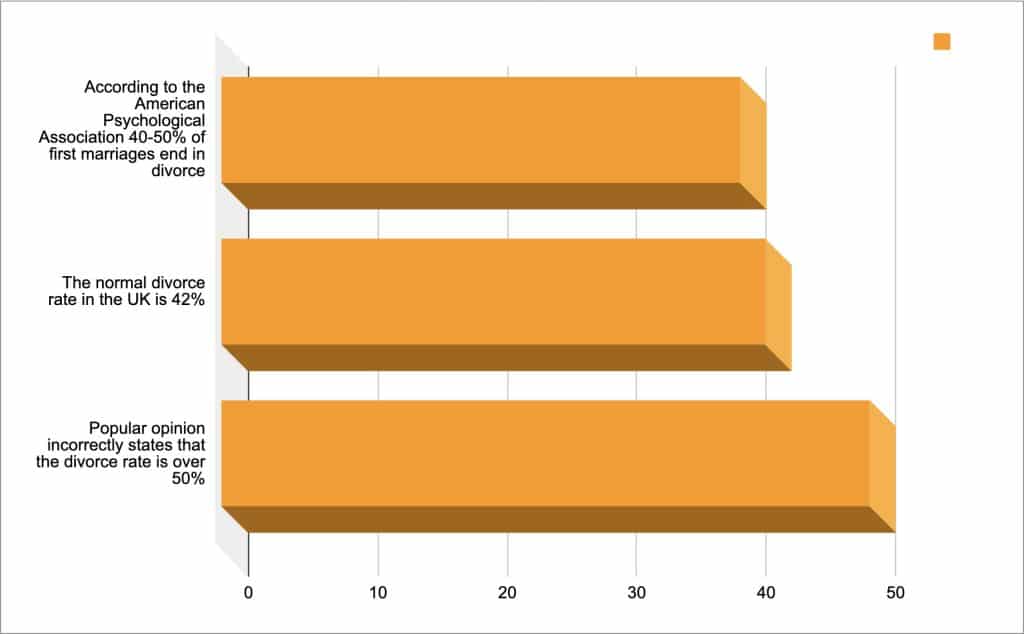How to Understand and Compare the Worldwide Divorce Rate
Divorce is a common phenomenon in many countries, but how common is it exactly? How do we measure the divorce rate and how does it vary across countries and regions?

What is the divorce rate and how is it calculated?
The divorce rate is a measure of how frequently marriages end in divorce in a given population. There are different ways to calculate the divorce rate, depending on the data and the purpose of the analysis. Here are some of the most common methods:
• The crude divorce rate is the number of divorces per 1,000 population in a given year. For example, if a country has 10 million people and 50,000 divorces in one year, then the crude divorce rate for that year is 5 divorces per 1,000 people. This method is easy to calculate and compare across countries and regions, but it has some limitations. For instance, it does not take into account the size and composition of the married population, which may vary depending on the age structure, the marriage rate, and the remarriage rate of the population. Therefore, a high crude divorce rate may not necessarily mean that marriages are more likely to end in divorce, but rather that there are more married people in the population.
• The refined divorce rate is the number of divorces per 1,000 married people in a given year. This method is more specific and accurate than the crude divorce rate, as it only considers the population that is at risk of divorce, namely the married population. However, it also has some drawbacks. For example, it does not account for the duration of marriage, which may affect the probability of divorce. Moreover, it may be difficult to obtain reliable data on the number of married people in some countries, especially if there are different types of marital unions, such as cohabitation, civil partnerships, or customary marriages.
• The divorce-to-marriage ratio is the number of divorces per 100 marriages in a given year. This method is useful to measure the relationship between the divorce rate and the marriage rate, and to assess the stability of marriages over time. However, it also has some limitations. For instance, it does not reflect the changes in the divorce rate and the marriage rate over time, as it only compares the annual figures. Furthermore, it does not consider the timing of divorce and marriage, which may differ depending on the legal and social norms of each country. For example, some countries may have a waiting period or a separation requirement before granting a divorce, while others may allow divorce by mutual consent or without any reason.
As we can see, there is no single or perfect way to measure the divorce rate, and each method has its own advantages and disadvantages. Therefore, it is important to use multiple methods and sources of data to get a more comprehensive and accurate picture of the divorce situation in different countries and regions.
What are the latest statistics on the worldwide divorce rate?
According to the latest available data from the United Nations and other sources, the crude divorce rate in 2019 ranged from 0.1 per 1,000 population in Sri Lanka to 4.5 per 1,000 population in the United States. The refined divorce rate in 2019 ranged from 0.2 per 1,000 married people in India to 26.9 per 1,000 married people in Russia. The divorce-to-marriage ratio in 2019 ranged from 1.6 per 100 marriages in Indonesia to 71.8 per 100 marriages in Kazakhstan.
The data also shows that the divorce rate has changed over time in different ways across countries and regions. For example, in the United States, the crude divorce rate peaked at 5.3 per 1,000 population in 1981, and then declined to 4.5 per 1,000 population in 2019. In contrast, in China, the crude divorce rate increased from 0.4 per 1,000 population in 1981 to 3.4 per 1,000 population in 2019. In some countries, such as France, Germany, and Japan, the crude divorce rate fluctuated over time, showing periods of increase and decrease.
Some of the factors that may explain the changes in the divorce rate over time are:
• The changes in the legal and social norms regarding divorce, such as the introduction or abolition of fault-based divorce, the recognition or rejection of no-fault divorce, the simplification or complication of the divorce procedures, and the acceptance or stigma of divorce in the society.
• The changes in the economic and demographic conditions that affect the marriage and divorce decisions, such as the level of income, education, employment, and urbanization, the availability and affordability of housing, health care, and child care, and the trends in fertility, mortality, and migration.
• The changes in the cultural and personal values and attitudes that influence the expectations and satisfaction of marriage, such as the degree of individualism, feminism, secularism, and liberalism, the importance of love, compatibility, and happiness, and the tolerance of conflict, infidelity, and abuse.
How to compare the divorce rate across countries and regions?
Comparing the divorce rate across countries and regions can be challenging, as there are many differences and variations in the data quality, availability, and definitions. Here are some tips and cautions to keep in mind when comparing the divorce rate across countries and regions:
• Use multiple methods and sources of data, and check the definitions, coverage, and reliability of the data. For example, some countries may only report the number of divorces granted by courts, while others may include the divorces granted by other authorities, such as religious or customary institutions. Some countries may only report the number of divorces for the whole country, while others may report the number of divorces for each region or province. Some countries may have more recent and complete data than others, while some countries may have no data at all.
• Use the same method and source of data for the countries and regions that you want to compare, and adjust the data if necessary. For example, if you want to compare the crude divorce rate across countries, use the same source of data for the number of divorces and the population, and make sure that the data are for the same year and the same age group. If you want to compare the refined divorce rate across countries, use the same source of data for the number of divorces and the number of married people, and make sure that the data are for the same year and the same marital status. If you want to compare the divorce-to-marriage ratio across countries, use the same source of data for the number of divorces and the number of marriages, and make sure that the data are for the same year and the same type of marriage.
• Consider the context and the factors that may affect the divorce rate in each country and region, and avoid making simplistic or hasty conclusions. For example, a high divorce rate may not necessarily mean that marriages are less stable or happy in a country, but rather that divorces are more accessible or acceptable in that country. A low divorce rate may not necessarily mean that marriages are more stable or happy in a country, but rather that divorces are less accessible or acceptable in that country. A change in the divorce rate over time may not necessarily mean that marriages are becoming more or less stable or happy in a country, but rather that other factors, such as legal, economic, demographic, cultural, or personal factors, are influencing the marriage and divorce decisions in that country.
In conclusion, the divorce rate is a complex and dynamic phenomenon that varies across countries and regions, and over time. It is influenced by a multitude of factors that interact with each other in different ways. Therefore, it is not possible to define a normal or average divorce rate that applies to all situations and contexts. Rather, it is more meaningful to understand the specific and contextual factors that shape the divorce rate in each country and region, and to monitor the trends and patterns of divorce over time.
***
https://harbourfamilylaw.co.uk/how-many-marriages-end-in-divorce-in-the-uk/
https://www.williamsons-solicitors.co.uk/news/divorce-statistics-2022/


